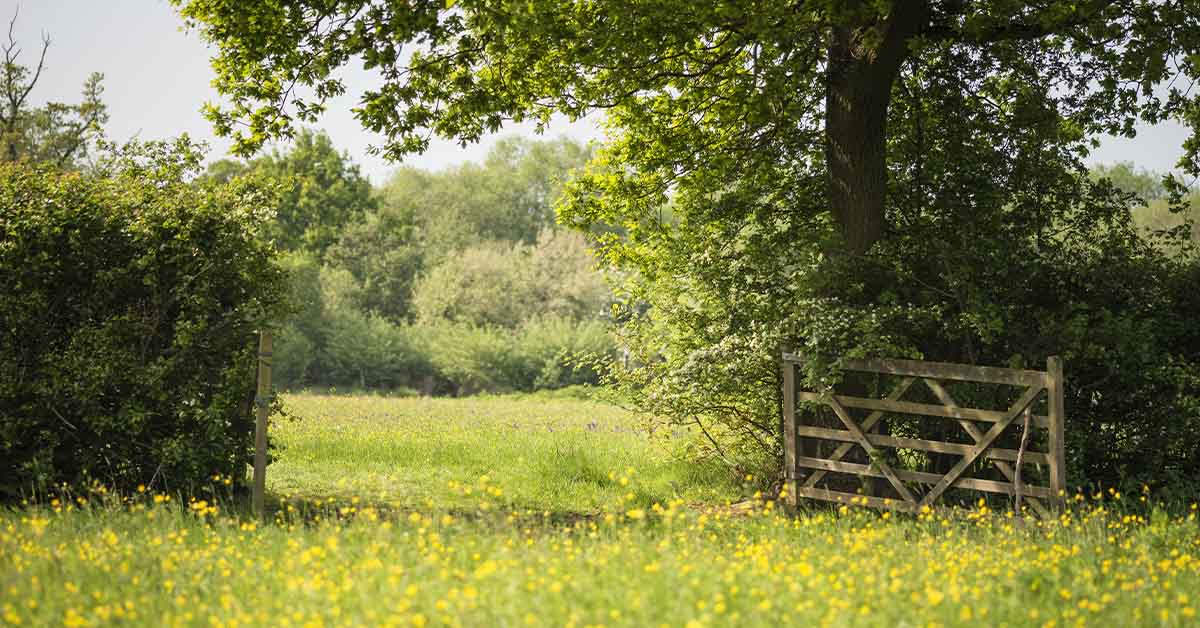The Green Unknown: might Conservation Covenants transform the English countryside?
Conservation Covenants (“CCs”) will allow landowners and developers to deliver “public money for public goods” through large-scale Environmental Land Management Schemes, tap into emerging private natural capital markets and discharge Biodiversity Net Gain obligations. If they are really to take off, the Government needs to align the tax regime with these environmental incentives.

CCs are a quietly radical innovation with the potential to revolutionize the way English and Welsh land is owned and managed. Introduced in the recent Environment Act and inspired by similar concepts in other countries, CCs will allow landowners to contract voluntarily with a “Responsible Body” to commit their land to “conservation”. They will be new “statutory burdens on land”, a unique and interesting mixture of new and existing legal instruments.
Tying up land long-term, perhaps even indefinitely, in such a specific way is a dramatic step and we will see how popular they become. Rural landowners will be expected to provide land for conservation and to meet Biodiversity Net Gain (“BNG”) and other targets, so CCs will be particularly relevant to them. Moreover, sustainability is now so embedded in the national consciousness that, soon, every development will have a conservation element, even if only to offset or outsource its obligations, and particularly to provide the BNG required for planning permissions.
In this article, we try and answer the following questions:
- What are CCs?;
- How will CCs work?; and
- Why would a landowner want to enter into a CC?

1. What are CCs?
1.1 Context
CCs have been part of the conservation conversation for some time. The Law Commission published a report in 2014 and the Government carried out a consultation in 2019. They also exist, in various forms, in other jurisdictions including Scotland, New Zealand, USA and Australia. England and Wales formally introduced them in the Environment Act, which received royal assent on 9 November 2021. CCs will come into being on 30 September 2022.
1.2 The legislation
Part 7 of the Environment Act is the Big Bang for CCs in England and Wales. There are two main elements. A landowner must contract:
- with a “Responsible Body”; and
- to use the land for a “conservation purpose”.
1.3 What is a Responsible Body (“RB”)?
RBs must be approved by the Government and have some kind of conservation purpose. They will be responsible for enforcing the landowner’s obligations, but it can be either the RB or the landowner who actually carries out the conservation work. Both the landowner and the RB can enforce against one another like parties in a conventional contract (RBs will not be arms of the state).
It seems likely that RBs will principally be large, national charities like the National Trust or the RSPB, but they could also be local (even community) bodies set up specifically for small-scale projects. They will not receive any public funding for administering CCs. At this stage, various questions arise:
- Will RBs be mainly existing bodies or new ones set up specifically to enter CCs?
- Will RBs be primarily national or local? (Even specific to particular CCs?)
- Will RBs be primarily mass-membership organisations like the National Trust, or private bodies like charitable trusts established by landowners?
- Where will RBs find the resources to carry out their obligations under CCs?
- Will RBs want public access to land within CCs (including to pay for them)?
1.4 What is a “conservation purpose”?
A conservation purpose must be intended to be for the public good and:
- to conserve the natural environment of land or the natural resources of land; or
- to conserve land as a place of archaeological, architectural, artistic, cultural or historic interest; or
- to conserve the setting of land with a natural environment or natural resources or which is a place of archaeological, architectural, artistic, cultural or historic interest.
It is so widely drawn that, arguably, pretty much any land might have a conservation purpose. The Government and Law Commission emphasize that the “public good” should be interpreted in the widest sense. It will be interesting to see how creatively this is interpreted. Ultimately, if challenged, the courts will decide whether a CC is valid or not, although sensible agreements will contain dispute resolution provisions.
1.5 CC legal foundations
CCs combine elements of:
- ordinary covenants, requiring the landowner to do or not do certain things on the land;
- special National Trust and Forestry Commission covenants, as RBs will be able to enforce them without owning adjoining land; and
- section 106 planning agreements, as CCs will appear on the Land Charges Register rather than the property’s title.
The really novel feature is that CCs can impose positive (as well as negative) obligations on a landowner’s successors.

2. How will CCs work?
Only when they come into force will we see how CCs work in practice. Meanwhile, the Environment Act give a sense of their shape:
2.1 Tenants
Whether a tenant can enter a CC without landlord’s consent is a grey area. Consequently, it will be in both parties’ interests for a tenant to seek landlord’s approval before entering into a CC.
The Government is keen for tenants to enter into CCs; there is no landlord consent requirement in the legislation. However, if the CC involves the tenant significantly altering their holding or farming practice, consent could be required.
Several commercial points flow from a tenant entering a CC. It could affect the rent review by enhancing or diminishing the land value. Who will own / have the benefit of any enhancement to the land arising from the CC? The tenant might seek compensation for any improvement to the value of the land. The landlord might argue that the CC has diminished the value of the land and seek damages. If a tenant CC prevents the landlord from developing the land then the diminution in value could be substantial. As with consent for alterations, the licence for consent should provide explicitly for these issues to avoid dispute later. In new leases, landlords should include a requirement for such a licence if a tenant wants to enter into a CC.
The legislation says anyone who owns land freehold or has a lease of more than seven years (no matter how much has expired) can enter into a CC. This poses problems for Agricultural Holdings Act (“AHA”) tenants. Although AHA tenants have high security of tenure and are long-term occupiers, AHA tenancies run year to year. Unless the Government clarifies or changes the legislation, AHA tenants may be excluded from CCs on this ground.
2.2 Duration
As noted above, CCs will bind the landowner’s successors in title. CCs can be indefinite but sensible landowners will agree a specific period with the RB . They will need to last for at least 30 years to secure Biodiversity Net Gain, which we cover below. For tenants, they will last until the end of the term. Significantly, if a tenancy is terminated early, (one year into a hundred-year term, for example) the CC would carry on for the remaining years and bind the landlord – another reason for landlords to insist the tenant seek their consent. Licences for consent should include protection against losses flowing from a tenant’s default, such as security over a deposit account.
2.3 Enforcement
Punishments for breaching CCs are the usual suspects: orders for specific performance of obligations; injunctions; damages; orders for payment of amounts due. The court will consider the public interest in choosing a remedy and could award exemplary / punitive damages against a landowner in excess of actual damage caused. The limitation period will be six years from the date of the breach, although as most breaches will be ongoing this could be elastic. Landowners will be able to use factors beyond their control and emergencies as defences. As CCs are private, contractual agreements there will be no criminal sanctions.
2.4 Discharge or modification
The landowner and RB can agree to modify or discharge a CC, though any modifications will still need to meet the “conservation purpose” criteria. Either party can also apply to the Upper Tribunal to modify or discharge CCs where reasonable, but the Upper Tribunal will not be able to take account of a change in a party’s circumstances making a CC unaffordable for that person, so long term cashflow will obviously need to be considered when entering a CC.
In practice, ongoing dialogue between a landowner and RB will be important, particularly in the early days. Parties should also agree a timeframe for reviewing a CC formally, say every two years.

3. Why would a landowner want to enter into a CC?
Time will tell how popular CCs are. The starting point is that CCs will restrict a landowner’s agency over their land and, therefore, devalue it, potentially substantially, depending on the opportunity cost. What’s more, there is no direct public funding so CCs will need to align with other revenue schemes.
3.1 Altruism / environmental reasons
The environmental movement is now so strong that many people are keen to do and be seen to do “the right thing” for the planet. CCs are one way of achieving this. As discussed, CCs’ “conservation purpose” is broad and could have wide appeal to protect specific things that people or companies want to preserve or enhance, whether in their lifetime or as a legacy. The point when land is transacted – whether sold, leased, or left or gifted to a family member – is a logical moment to enter into a CC. Even if environmental conscience is not the sole reason it will often be a factor in decision making alongside other considerations.
3.2 BNG
Every development requiring planning consent will need to show 10% BNG), another Environment Act innovation. So there is going to be a lot of BNG around; CCs will be one way of providing it as developers and builders will have the choice between CCs and planning obligations (typically delivered under section 106 agreements with local authorities). There will be a register of land on which BNG requirements are secured by CCs or planning obligations, but we do not yet know how detailed it will be. The main difference between CCs and section 106 agreements is enforcement; the latter will be enforced by the local authority whereas the former will be subject to an RB. Initially, developers will likely stick with the devil they know (section 106 agreements), but they could switch to CCs if they perceive them to be more flexible, more bespoke, more straightforward to agree and cheaper than section 106 agreements. Cynically, you might expect RBs (because of the uncertainty of their resources) to be less rigorous enforcers than local authorities.
3.3 Natural Capital Agreements
Natural capital agreements are where a landowner contracts with a third party to provide an environmental service, like carbon sequestration or tree planting. They are relatively new but likely to become popular as governments, companies and individuals take steps to reduce their carbon footprint and environmental impact. Currently, they take the form of leases or service contracts. CCs could be a way to secure and enforce the environmental obligations within natural capital agreements, like a charge or a restriction on a property’s title to protect an overage agreement or other obligation. They could also tie into the Environmental Land Management Schemes (“ELMS”) we cover below.
3.4 Tax incentives
Tax is the elephant in the forest here. At the moment there are no tax incentives for CCs – the Government wants CCs (and indeed all natural capital arrangements) to be primarily private sector funded. But that could change if it wants to promote them and join up incentives for landowners. In other countries there seems to have been major take up only where there is a tax incentive (the USA is world-leader here, with federal income tax deductions and state tax credits). Agricultural subsidy reform may push landowners towards more sustainable management, but this does not align with the tax regime yet; notably inheritance tax with its traditional definitions of agriculture for Agricultural Property Relief and business for Business Property Relief. Without a change in the law, entering land into environmental schemes and pursuing less conventional farming will jeopardize both reliefs. This is a key policy focus in the rural world.
3.5 Environmental Land Management Schemes (ELMS)
CCs are well-suited to Landscape Recovery Schemes (“LR Schemes”). LR Schemes are the largest, most ambitious ELMS component, intended for landowners who (according to DEFRA) want to “take a more radical and large-scale approach to producing environmental and climate goods on their land”, they will operate over 500 to 5,000 hectares and are expected to last for at least 20 years. Most LR Schemes will require co-operation by groups of landowners, which is where CCs come in. DEFRA suggests CCs could be used to secure agreement between landowners and secure the LR Schemes, as with natural capital agreements.
Applications for pilot LR Schemes opened on 1 February 2022 and up to fifteen will be chosen in the summer of 2022. Like CCs, LR Schemes are yet to come into force. This is a space worth watching. We do not know how much money will be available for LR Schemes. Each will be bespoke, and the Government says they must secure private as well as public funding. Indeed, LR Schemes are intended to help landowners access the growing market for natural capital services like carbon sequestration and to develop standards and rules for those markets.
While some landowners will go the full Knepp and rewild, most will want to ensure that land in LR Schemes can still be farmed commercially (including to qualify for inheritance tax reliefs). Therefore, those negotiating and drafting CCs should take care that they are not too restrictive of farming and other activities. And, as suggested above, well-drafted CCs will include a review mechanism. On the ground, this will be complex, particularly as LR Schemes will probably involve several landowners.
Conclusion
Farming and landowning in the UK are in a period of regulatory and economic uncertainty. If the Government wants farmers to deliver public goods (as well as food security), it needs to ensure ELMS provides sufficient public money. It also needs to reform tax reliefs to reward conservation. CCs are potentially a good means by which landowners can deliver conservation – especially on a large scale with ELMS – but on their own they are not enough.

